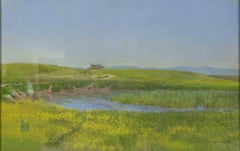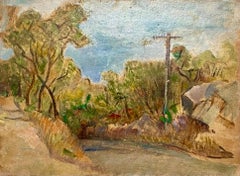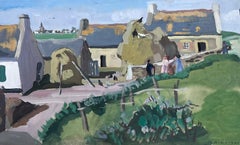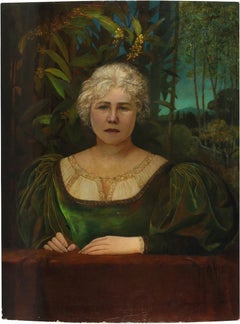Edoardo Gioja Paintings
to
2
2
2
2
Overall Height
to
Overall Width
to
2
2
2
2
2
2
2
2
2
3
849
657
649
610
2
2
2
Artist: Edoardo Gioja
Roman Countryside - Mixed Media by E. Gioja - 1908
By Edoardo Gioja
Located in Roma, IT
Roman Countryside is an original modern artwork realized in 1908 by Edoardo Gioja.
Mixed media. Hand signed and dated on the lower right margin.
Includes frame.
Edoardo Gioja (Rome, 1862 - Rome, 1937), an Italian painter and artist. He treated the decoration and portrait with Pre-Raphaelite taste. Influenced by Nino Costa, he repudiated genre painting by reproducing marines, countries, plants, animals and painted and drew with simplicity and with very effective results. He decorated several rooms in London and prepared cartoons for stained glass...
Category
Early 1900s Modern Edoardo Gioja Paintings
Materials
Tempera, Watercolor
Roman Countryside - Mixed Media by E. Gioja - 1908
By Edoardo Gioja
Located in Roma, IT
Roman Countryside is an original modern artwork realized in 1908 by Edoardo Gioja.
Mixed media. Hand signed and dated on the lower right margin.
Includes frame.
Edoardo Gioia (Rome, 1862 - Rome, 1937), an Italian painter and artist. He treated the decoration and portrait with Pre-Raphaelite taste. Influenced by Nino Costa, he repudiated genre painting by reproducing marines, countries, plants, animals and painted and drew with simplicity and with very effective results. He decorated several rooms in London and prepared cartoons for stained glass...
Category
Early 1900s Modern Edoardo Gioja Paintings
Materials
Tempera, Watercolor
Related Items
Simka Simkhovitch WPA Artist Oil Painting Gouache American Modernist Powerline
By Simka Simkhovitch
Located in Surfside, FL
Simka Simkhovitch (Russian/American 1893 - 1949)
This came with a small grouping from the artist's family, some were hand signed some were not.
These were studies for larger paintings.
Simka Simkhovitch (Симха Файбусович Симхович) (aka Simka Faibusovich Simkhovich) (Novozybkov, Russia May 21, 1885 O.S./June 2, 1885 N.S.—Greenwich, Connecticut February 25, 1949) was a Ukrainian-Russian Jewish artist and immigrant to the United States. He painted theater scenery in his early career and then had several showings in galleries in New York City. Winning Works Progress Administration (WPA) commissions in the 1930s, he completed murals for the post offices in Jackson, Mississippi and Beaufort, North Carolina. His works are in the permanent collections of the Dallas Museum of Art, the National Museum of American Art and the Whitney Museum of American Art. Born outside Kyiv (Petrograd Ukraine) into a Jewish family who owned a small department store. During a severe case of measles when he was seven, Simcha Simchovitch sketched the views outside his window and decided to become an artist, over his father's objections. Beginning in 1905, he studied at the Grekov Odessa Art School and upon completion of his studies in 1911 received a recommendation to be admitted to the Imperial Academy of Arts. Though he enrolled to begin classes in architecture, painting, and sculpture at the Imperial Academy, he was dropped from the school roster in December because of the quota on the number of Jewish students and drafted into the army. Simchovitch served as a private in the 175th Infantry Regiment Baturyn [ru] until his demobilization in 1912. Re-enrolling in the Imperial Academy, he audited classes.
Simka Simkhovitch exhibited paintings and sculptures in 1918 as part of an exhibition of Jewish artists and in 1919 placed 1st in the competition "The Great Russian Revolution" with a painting called "Russian Revolution" which was hung in the State Museum of Revolution. In 1922, Simkha Simkhovitch exhibited at the International Book Fair in Florence (Italian: Fiera Internazionale del Libro di Firenze). In 1924, Simkhovitch came to the United States to make illustrations for Soviet textbooks and decided to immigrate instead. Initially he supported himself by doing commercial art and a few portrait commissions. In 1927, he was hired to paint a screen for a scene in the play "The Command to Love" by Fritz Gottwald and Rudolph Lothar which was playing at the Longacre Theatre on Broadway. Art dealers began clamoring for the screen and Simkhovitch began a career as a screen painter for the theater. Catching the attention of the screenwriter, Ernest Pascal, he worked as an illustrator for Pascal, who then introduced him to gallery owner, Marie Sterner. Simkhovitch's works appeared at the Marie Sterner Gallery beginning with a 1927 exhibit and were repeated the following year. Simkhovitch had an exhibit in 1929 at Sterner's on circus paintings. In 1931, he held a showing of works at the Helen Hackett Gallery, in New York City and later that same year he was one of the featured artists of a special exhibit in San Francisco at the California Palace of the Legion of Honor in Lincoln Park. The exhibit was coordinated by Marie Sterner and included four watercolors, including one titled "Nudes". He is of the generation of Russian Soviet artists such as Isaac Pailes, Serge Charchoune, Marc Chagall, Chana Orloff, Isaac Ilyich Levitan, and Ossip Zadkine.
In 1936, Simkhovitch was selected to complete the mural for the WPA Post office project in Jackson, Mississippi. The mural was hung in the post office and courthouse in 1938 depicted a plantation theme. Painted on the wall behind the judge’s bench, “Pursuits of Life in Mississippi”, a depiction of black workers engaged in manual labor amid scenes of white professionals and socialites, was eventually covered over in later years during renovations due to its stereotypical African American imagery. Simka painted what he thought was typical of Jackson. His impression of pre-civil rights Mississippi was evidently Greek Revival column houses, weeping willow trees, working class families, and the oppression of African Americans. He painted African American men picking cotton, while a white man took account of the harvest and a white judge advised a white family, calling it Pursuits of Life in Mississippi.
Though clearly endorsed by the government and initially generally well-received, the mural soon raised concerns with locals as the climate toward racial segregation began to change. The main concern was whether depictions that show African Americans in subjugated societal roles should be featured in a courtroom. The following year, his painting "Holiday" won praise at an exhibition in Lincoln, Nebraska. In 1940, Simkhovitch's second WPA post office project was completed when four murals, "The Cape Lookout Lighthouse and the Orville W. Mail Boat", "The Wreck of the Crissie Wright", "Sand Ponies" and "Canada Geese" were installed in Beaufort, North Carolina. The works were commissioned in 1938 and did not generate the controversy that the Jackson mural had. The main mural is "The Wreck of the Crissie Wright" and depicts a shipwreck which had occurred in Beaufort in 1866. "The Cape Lookout Lighthouse and the Orville W. Mail Boat" depicted the lighthouse built in 1859 and the mail boat that was running mail during the time which Simkhovitch was there. The boat ran mail for the area until 1957. "Sand Ponies" shows the wild horses common to the North Carolina barrier islands and "Canada Geese" showed the importance of hunting and fishing in the area. All four murals were restored in the 1990s by Elisabeth Speight, daughter of two other WPA muralists, Francis Speight...
Category
1930s American Modern Edoardo Gioja Paintings
Materials
Gouache, Oil, Board
1950's French Impressionist Painting Ladies Gossiping On The Town Bridge
Located in Cirencester, Gloucestershire
Ladies Gossiping
by Y. Blanchon, French 1950's Impressionist artist
signed gouache on artist paper stuck on paper, unframed
size: 12.5 x 19.5 inches
provenance: from a large private ...
Category
Mid-20th Century Modern Edoardo Gioja Paintings
Materials
Gouache
Antique American School Signed Illustration Indian Royalty Elephant Painting
Located in Buffalo, NY
Antique illustration painting. Gouache and watercolor on board, circa 1920. Signed. Image size, 12L x 11H. Housed in a period frame.
Category
1920s Modern Edoardo Gioja Paintings
Materials
Gouache, Watercolor
H 16 in W 17 in D 1 in
Rabbit Hunters
By Roger Medearis
Located in Los Angeles, CA
Rabbit Hunters, egg tempera on Masonite, 12 x 9 inches, 1947, signed and dated lower left, signed, titled and dated verso “Rabbit Hunters Egg Tempera Roger Medearis 1947,” exhibited ...
Category
1940s American Modern Edoardo Gioja Paintings
Materials
Tempera, Board
Acoma Pueblo, New Mexico, 1970s Southwest Landscape Scene Gouache Painting
Located in Denver, CO
"Acoma Pueble (New Mexico) is a gouache on paper painting by Wolfgang Pogzoba (1936-1982) from 1978 of a landscape and an adobe home over a cliff side in the town of Acoma Pueblo, NM. Presented in a custom frame, outer dimensions measure 22 ⅜ x 25 inches. Image size is 12 x 15 inches. The Acoma Pueblo is located approximately 60 miles west of Albuquerque, New Mexico.
Painting is clean and in good condition - please contact us for a detailed condition report.
Expedited and international shipping is available - please contact us for a quote.
About the Artist:
Wolfgang Pogzeba...
Category
1970s American Modern Edoardo Gioja Paintings
Materials
Gouache, Paper
Mid Century Landscape Figure Painting Art Institute of SF Green, Red, Blue
By Gloria Dudfield
Located in Arp, TX
Gloria Dudfield (1922-2015)
Untitled
c.1960s
Gouache on paper
18"x15" unframed
Unsigned
Came from a portfolio of her work in the San Francisco Bay Area.
Gloria had a Master of Arts...
Category
Mid-20th Century Modern Edoardo Gioja Paintings
Materials
Gouache, Paper
Golden Cycle Mill, Colorado, 1940s WPA Mining Watercolor Landscape, Black White
By Charles Ragland Bunnell
Located in Denver, CO
Original 1940s watercolor on paper painting by Charles Ragland Bunnell portraying a semi abstracted view of Golden Cycle Mill in Colorado Springs, Colorado. Painted in shades of black and gray. Presented in a custom black frame, outer dimensions measure 18 x 19 ½ x 1 ⅜ inches. Image sight size is 8 ⅛ x 9 ⅝ inches.
Golden Cycle Mining and Reduction Company was a mining company in Colorado City (now Old Colorado City) in El Paso County, Colorado.
Piece is clean and in excellent condition - please contact us for a detailed condition report.
Expedited and international shipping is available - please contact us for a quote.
About the artist:
Artist and teacher, Charles (“Charlie”) Bunnell worked in a variety of styles throughout his career because as an artist he believed, “I’ve got to paint a thousand different ways. I don’t paint any one way.” At different times he did representational landscapes while concurrently involved with semi- or completely abstract imagery. He was one of a relatively small number of artists in Colorado successfully incorporating into their work the new trends emanating from New York and Europe after World War II. During his lifetime he generally did not attract a great deal of critical attention from museums, critics and academia. However, he personally experienced a highpoint in his career when Katherine Kuh, curator at the Art Institute of Chicago, personally chose one of his paintings – Why? - for its large exhibition of several hundred examples of abstract and surrealist art held in 1947-48, subsequently including it among the fifty pieces selected for a traveling show to ten other American museums.
An only child, Bunnell developed his love of art at a young age through frequent drawing and political cartooning. In high school he was interested in baseball and golf and also was the tennis champion for Westport High School in Kansas City. Following graduation, his father moved the family to Denver, Colorado, in 1916 for a better-paying bookkeeping job, before relocating the following year to Colorado Springs to work for local businessman, Edmond C. van Diest, President of the Western Public Service Company and the Colorado Concrete Company. Bunnell would spend almost all of his adult life in Colorado Springs.
In 1918 he enlisted in the United States Army, serving in the 62nd Infantry Regiment through the end of World War I. Returning home with a 10% disability, he joined the Zebulon Pike Post No. 1 of the Disabled American Veterans Association and in 1921 used the benefits from his disability to attend a class in commercial art design conducted under a government program in Colorado Springs. The following year he transferred to the Broadmoor Art Academy (founded in 1919) where he studied with William Potter and in 1923 with Birger Sandzén. Sandzén’s influence is reflected in Bunnell’s untitled Colorado landscape (1925) with a bright blue-rose palette.
For several years thereafter Bunnell worked independently until returning to the Broadmoor Art Academy to study in 1927-28 with Ernest Lawson, who previously taught at the Kansas City Art Institute where Bunnell himself later taught in the summers of 1929-1930 and in 1940-41. Lawson, a landscapist and colorist, was known for his early twentieth-century connection with “The Eight” in New York, a group of forward-looking painters including Robert Henri and John Sloan whose subject matter combined a modernist style with urban-based realism. Bunnell, who won first-place awards in Lawson’s landscapes classes at the Academy, was promoted to his assistant instructor for the figure classes in the 1928-29 winter term. Lawson, who painted in what New York critic James Huneker termed a “crushed jewel” technique, enjoyed additional recognition as a member of the Committee on Foreign Exhibits that helped organize the landmark New York Armory Exhibition in 1913 in which Lawson showed and which introduced European avant-garde art to the American public.
As noted in his 1964 interview for the Archives of American Art in Washington, DC, Bunnell learned the most about his teacher’s use of color by talking with him about it over Scotch as his assistant instructor. “Believe me,” Bunnell later said, “[Ernie] knew color, one of the few Americans that did.” His association with Lawson resulted in local scenes of Pikes Peak, Eleven Mile Canyon, the Gold Cycle Mine near Colorado City and other similar sites, employing built up pigments that allowed the surfaces of his canvases to shimmer with color and light. (Eleven Mile Canyon was shown in the annual juried show at the Carnegie Institute in Pittsburgh in 1928, an early recognition of his talent outside of Colorado.) At the same time, he animated his scenes of Colorado Springs locales by defining the image shapes with color and line as demonstrated in Contrasts (1929). Included in the Midwestern Artists’ Exhibition in Kansas City in 1929, it earned him the gold medal of the Kansas City Art Institute, auguring his career as a professional artist.
In the 1930s Bunnell used the oil, watercolor and lithography media to create a mini-genre of Colorado’s old mining towns and mills, subject matter spurned by many local artists at the time in favor of grand mountain scenery. In contrast to his earlier images, these newer ones – both daytime and nocturnal -- such as Blue Bird Mine essentially are form studies. The conical, square and rectangular shapes of the buildings and other structures are placed in the stark, undulating terrain of the mountains and valleys devoid of any vegetation or human presence. In the mid-1930s he also used the same approach in his monochromatic lithographs titled Evolution, Late Evening, K.C. (Kansas City) and The Mill, continuing it into the next decade with his oil painting, Pikes Peak (1942).
During the early 1930s he studied for a time with Boardman Robinson, director of the Broadmoor Art Academy and its successor institution, the Colorado Springs Fine Arts Center from 1930 to 1947. In 1934 Robinson gave him the mural commission under the Public Works of Art Project (PWAP) for West Junior High School in Colorado Springs, his first involvement in one of several New Deal art...
Category
1940s American Modern Edoardo Gioja Paintings
Materials
Paper, Watercolor
The biggest house in town - Figurative Gouache Painting, Landscape, Architecture
By Piotr Fąfrowicz
Located in Warsaw, PL
PIOTR FĄFROWICZ (born in 1958). He studied art history at the Catholic University of Lublin. He deals with painting and graphic design. Winner of numerous awards for illustrations, i...
Category
21st Century and Contemporary Other Art Style Edoardo Gioja Paintings
Materials
Paper, Tempera, Gouache
The Dacha. Contemporary Painting
By Carola Richards
Located in Brecon, Powys
Early work was impressionistic and hard abstract. Carola later developed a more mature way of working in a colourful exploration of the subject.
Colour was her main interest and she...
Category
1990s Modern Edoardo Gioja Paintings
Materials
Oil, Gouache
Mid Century Modern Mixed Media Painting -- Day at the Beach
Located in Soquel, CA
Wonderful mid century mixed media coastal/figurative in loose/painterly style by Irmal Gertrude Attridge (American, 1894-1962), circa 1950. Signed lower right. Presented in vintage frame under glass (included as-is). Image size: 9"H x 12"W.
Irma Gertrude Attridge was born in Chicago and studied at Chouinard Art Institute in Los Angeles with Henry McFee and Oscar Van Young. Member of Calif. AC; AEA; Cal. WC. Soc.; Women Painters...
Category
1950s Modern Edoardo Gioja Paintings
Materials
Ink, Color Pencil, Watercolor
H 13.82 in W 16.25 in D 0.5 in
City view - XX century, Gouache on cardboard, Figurative, Landscape
By Magdalena Spasowicz
Located in Warsaw, PL
MAGDALENA SPASOWICZ Studied painting under prof. Jan Cybis and graphic arts with prof. Tadeusz Kulisiewicz at the Academy of Fine Arts in Warsaw. She received her diploma in 1953. He...
Category
20th Century Other Art Style Edoardo Gioja Paintings
Materials
Gouache, Cardboard, Tempera
Artists Sketching, California, 1940s Large Modernist Gouache Landscape Painting
By Frederick Shane
Located in Denver, CO
"Artists Sketching (California)" is an American Modernist scene of three artists working with mountains in the background. Gouache on paper, signed, titled, and dated by the artist in the lower margin. Housed in a custom frame with all archival materials measuring 25.5 x 37.5 x 1.5 inches; image dimensions measure 20.25 x 29.75 inches.
Provenance: Estate of the Artist, Frederick Shane
About the artist:
Painter and printmaker, Missouri regionalist Frederick E. Shane specialized in genre scenes, landscapes, seascapes and portraits executed in a variety of media: oil, watercolor, mixed media, gouache, tempera and lithography. Fundamentally a realist, his work also contains some abstraction, expressionism and surrealism used in treating his subject matter.
In the summers of 1925-26 Shane studied with Randall Davey at the recently-founded Broadmoor Academy in Colorado Springs. The Academy was established in 1919 by Spencer and Julie Penrose, prominent philanthropists and art patrons, who donated their family residence for the creation of a local art institution. In the 1940s and early 1950s Shane maintained his contact with Colorado Springs Fine Arts Center (the successor institution to the Broadmoor Academy in 1936). He participated in a number of its annual Artists West of the Mississippi exhibitions and also became a close friend of Boardman Robinson, the Center’s director, and visiting artist Adolph Dehn...
Category
1940s American Modern Edoardo Gioja Paintings
Materials
Gouache
Frederick ShaneArtists Sketching, California, 1940s Large Modernist Gouache Landscape Painting, 1949
H 25.5 in W 37.5 in D 1.5 in
Previously Available Items
Woman in the Nature - Oil on Panel by E. Gioja - Early 1900
By Edoardo Gioja
Located in Roma, IT
Woman in the Nature is an original modern artwork realized by the Italian modern artist Edoardo Gioja in the first years of the XX Century.
Original oil painting on panel.
Hand-signed on the lower right corner.
Mint conditions.
Interesting painting on canvas characterized by a naive taste. The figure of the woman wears medieval clothes and the tissues are treated in an extremely refined way. The figure is immerged in a luxuriant and verdant nature. This work has been realized by Edoardo Gioia (Rome, 1862 - Rome, 1937), an Italian painter and artist. He treated the decoration and portrait with Pre-Raphaelite taste. Influenced by Nino Costa, he repudiated genre painting by reproducing marines, countries, plants, animals and painted and drew with simplicity and with very effective results. He decorated several rooms in London and prepared cartoons for stained glass...
Category
Early 20th Century Edoardo Gioja Paintings
Materials
Oil, Panel
H 36.03 in W 26.78 in D 1.19 in
Edoardo Gioja paintings for sale on 1stDibs.
Find a wide variety of authentic Edoardo Gioja paintings available for sale on 1stDibs. You can also browse by medium to find art by Edoardo Gioja in paint, tempera, watercolor and more. Much of the original work by this artist or collective was created during the early 1900s and is mostly associated with the modern style. Not every interior allows for large Edoardo Gioja paintings, so small editions measuring 22 inches across are available. Customers who are interested in this artist might also find the work of Jean Calogero, Vittorio Maria Di Carlo, and Nazareno Gattamenata. Edoardo Gioja paintings prices can differ depending upon medium, time period and other attributes. On 1stDibs, the price for these items starts at $3,365 and tops out at $3,365, while the average work can sell for $3,365.




